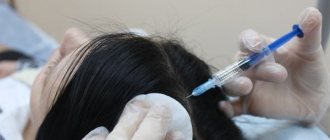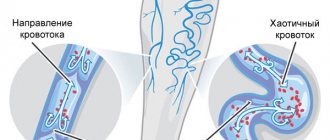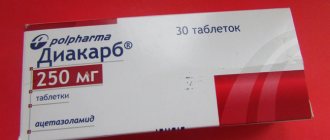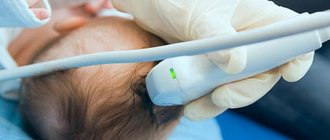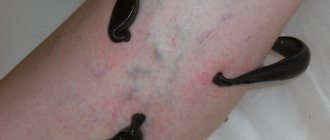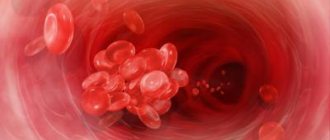Vegetative-vascular dystonia is such an unpleasant disorder that the sufferer is ready to take any medicine to make it feel better. Many dystonics are prescribed Piracetam for VSD. The drug belongs to the nootropics. It has an affordable price, a wide spectrum of action and a minimum of side effects. Reviews for it are mostly positive. Let's take a closer look at this drug. I will also share my personal opinion about the action of Piracetam in functional disorders of the nervous system. I’ve had to drink it more than once, so I have something to share.
Do not forget that only a doctor can make the correct diagnosis and prescribe treatment. The material is presented for informational purposes only and is not a reason for self-medication or independent use of medications.
Piracetam - release form and composition
The main active ingredient of the drug is piracetam.
The following are used as auxiliary components: povidone K-25; magnesium carbonate basic, light; calcium stearate; potato starch; opadry II white (85G).
The medicine has several forms of release:
- Ampoules for intravenous and intramuscular administration.
- Capsules.
- Pills.
- Special dragees for children.
The content of the active substance also varies. each capsule/tablet may contain from 0.2 g to 0.8 g of piracetam. The dosage is always indicated on the medication packaging.
Since the medicine has to be taken over a long course, it is most often sold in packs of 60-100 tablets at a time. But you can also find individual blisters.
Book an appointment with a psychotherapist online
The drug is produced by many pharmacological companies, so you should not be surprised at the different packs and manufacturers.
For vegetative-vascular dystonia, Piracetam is most often prescribed in capsules or tablets. If the patient's condition is serious, the doctor may prescribe medicine in injections.
How to avoid side effects?
Any undesirable effects, as a rule, appear when the instructions are violated. But sensitive VSDs often become hostage to their new sensations after taking the drug. The main thing is not to exceed the dosage and never take Piracetam for vegetative-vascular dystonia without the doctor’s approval, since a drug that affects blood flow can aggravate existing diseases or add serious problems to the patient.
What undesirable things can happen after taking it (or during treatment)?
- Metabolic disorders and, as a result, weight gain;
- Unpredictable reaction of the central nervous system in the form of drowsiness, deterioration of psychological state, increased libido, internal trembling, increased headaches, aggression, emotional instability;
- Gastrointestinal disorders and vomiting;
- Hives;
- Increased blood pressure;
These symptoms may manifest themselves in the mildest degree, so that the patient may not even attach any importance to them. But in case of an overdose, the listed phenomena will hit the body with a vengeance.
If you have violated the dosage, call an ambulance immediately. Before that, take a few tablets of activated carbon with plenty of water.
The drug is contraindicated during pregnancy and breastfeeding, as well as for serious problems with the kidneys and heart. It is also dangerous for patients who have undergone deep surgical interventions to take Piracetam.
Source: vsdshnik.com
pharmachologic effect
Piracetam is a nootropic drug. If you don’t yet know what nootropics are and how they are useful, especially for VSD, I highly recommend reading this article.
The drug has a positive effect on metabolic processes in nerve cells and blood circulation in the brain.
The active substance increases glucose utilization, improves metabolic processes, improves microcirculation in ischemic areas, and inhibits the aggregation of activated platelets.
It has a protective effect against brain damage caused by hypoxia, intoxication, and electric shock. Improves integrative brain activity. Does not have a sedative or psychostimulating effect.
In simple terms, Piracetam is something like a vitamin for the brain. It improves the functioning of our “control center”. And along with this, all cognitive functions.
The medication has very good digestibility and low toxicity. It is prescribed without much concern to elderly people and even very young children. The main part of the substance is excreted through the kidneys.
On a note!
Piracetam is considered a drug with unproven effectiveness. Its effect is still being researched. There are no clear conclusions from experts about the benefits or uselessness of this medicine. But the experience of doctors and patients proves that the medication works according to all its declared properties.
What are nootropics
A nootropic is not a medicine that treats any disease. In simple terms, this is a vitamin for the brain.
According to the World Health Organization, nootropics are pharmacological agents that stimulate and activate cognitive processes in humans, improve learning abilities, perceive information and assimilate it, improve memory, increase the brain’s resistance to stress and the effects of various injuries, hypoxia and intoxication.
Medicines are available in the form of tablets, capsules, injections for intramuscular and intravenous administration.
Nootropics are not assigned a specific class in the international drug classification registry. They are combined with a group of psychostimulant medications. Such products have a very wide range of indications. Nootropics are especially often prescribed for VSD and neuroses to improve brain function. They are prescribed not only to adults, but also to children (sometimes even infants), often to the elderly.
In many countries, nootropic medications are sold without a doctor's prescription.
Indications for use
The instructions for the drug indicate that it is indicated for:
- Cerebral circulation disorders.
- Dementia (dementia), which occurs more often in old age due to cerebral circulatory disorders (ischemic stroke).
- Comatose states of traumatic, vascular or toxic etiology.
- Brain injuries of various types.
- Cortical myoclonus.
- Alzheimer's disease.
- Vegetative-vascular dystonia of hypotonic, mixed and hypertonic type.
- Neurotic disorders.
- Diseases of the nervous system, accompanied by a decrease in intellectual-mnestic functions and disturbances in the emotional-volitional sphere.
- Childhood dyslexia, usually in combination with other methods, including speech therapy.
- Psychosomatic syndromes occurring with decreased attention, memory, ability to concentrate and activity, behavior disorder, mood changes, and gait disturbance.
- Sickle cell anemia, including vaso-occlusive crisis.
- Vertigo (dizziness) and associated imbalances (with the exception of dizziness of psychogenic and vasomotor origin);
- Psychoorganic syndrome and abstinence and chronic alcoholism.
- Complex therapy of depressive conditions resistant to antidepressants.
- In pediatrics, if necessary, speed up the learning process and eliminate the consequences of perinatal brain damage, mental retardation, mental retardation, and cerebral palsy.
Drug interactions
It is important to remember that if you use this drug for a long time, while simultaneously combining it with other similar drugs, it can provoke hyperstimulation of the functioning of the central nervous system. This situation should not be allowed so as not to harm your own body.
The simultaneous use of Pantogam and other drugs gives the following effect:
- prolongs the exposure time of barbiturates;
- enhances the effect of drugs against seizures, novocaine, procaine and other analgesics used locally;
- eliminates the development of adverse reactions while taking antipsychotics (Carbamazepine, Phenobarbital);
- may influence the effects that some medicinal plants have on the body.
Important! The effect that Pantogam gives may be enhanced if you take Glycine or Xidifon (also other drugs containing etidronic acid) at the same time.
What is the use of Piracetam for VSD
Vegetative-vascular dystonia is a complex disorder of the nervous system. The vegetative department is responsible for the regulation of almost all life processes of the body. All of them occur without our participation (breathing, digestion, thermoregulation, etc.). And then, one fine day, this system fails. A person begins to feel several unpleasant symptoms at once.
VSD is such a thing that it rarely expresses itself in only one symptom. This is her main cunning.
The sufferer begins to feel symptoms typical of dystonia:
- Memory impairment.
- Decreased concentration.
- "Fog" in the head.
- Sudden mood swings.
- Depression.
- Lethargy, fatigue.
- Drowsiness during the day and poor sleep at night.
- Dizziness.
- Lack of air.
- Unsteadiness of gait.
- Frequent headaches.
- Interruptions in the functioning of the heart.
- Coldness of hands and feet.
- Increased sweating.
- Chills, trembling in the body.
- Blood pressure surges.
These are not all the symptoms that VSD can present, but they are the most common. Piracetam helps relieve or reduce the manifestations of vegetative lability.
Classification of prescribed medications
If there is a disorder in the vegetative-vascular system of a mixed type, breathing exercises are recommended for treatment. Mixed disorder can be countered by focusing on deep and measured breathing. Mixed conditions require work on strengthening the nervous system. The best thing that is recommended for those suffering from mixed disorder is to brew herbal teas.
For dystonia of the hypertensive type, sedatives are used for treatment. Salt, caffeine, fats and alcohol are contraindicated for hypertensive dystonic patients. Hypertensive patients need physical activity, reflexology and water treatments. Vegetables and fruits, chocolate are recommended for hypertension.
Patients with hypotonic disorders will be relieved by ginseng and eleutherococcus. They are not prescribed to a hypotensive patient with increased excitability or insomnia. Baths and showers are recommended for a hypotonic state. Hypotonic dystonics need exercise therapy and reflexology.
For the treatment of VSD the following drugs are prescribed:
- Antidepressants are a group of psychotropic substances. Antidepressants improve mood, reduce or completely eliminate depression and apathy. Antidepressants relieve irritability and emotional stress. Antidepressants are taken for a course of at least six months. Antidepressants begin to act within 10-14 days from the start of treatment. Only a doctor will determine which antidepressant medications to prescribe;
- neuroleptics are psychotropic drugs;
- Tranquilizers are designed to relieve anxiety and relieve fear. Medicines are characterized by sedative, anticonvulsant, muscle relaxant and hypnotic effects;
- sedatives.
The mildest are sedatives, the strongest are antidepressants.
Nootropics are used to get rid of fears. They have a positive effect on the brain - normalize its functions and stimulate blood flow. Nootropics are Tenoten, Phenibut, Phezam, Phenotropil, Pantogam, etc. The metabolic group to which Glycine belongs also provides an anxiolytic effect.
Patients are also recommended other drugs that affect only the external manifestations of the disorder, without in any way affecting the root cause of their appearance. These include various new restorative drugs:
- mineral complexes containing magnesium, zinc and selenium;
- enzyme;
- beta-blockers (Mexidol, Anaprilin, Propranol);
- metabolic compounds (Actovegin, Riboxin);
- vitamins C and B,
- medications that normalize the functionality of the cardiovascular system;
- adaptogens are any compounds that increase resistance to negative external influences.
Phytotherapy
At the initial stage of the disease, VSD is treated with soothing herbs: valerian root, hawthorn, motherwort, peony tincture, oregano, lemon balm, thyme.
Medicines prepared from herbal preparations using an industrial method are also effective - Novopassit, Negrustin, Persen.
Vitamins and homeopathy
Vitamins are useful regardless of what type of disease (hypertensive, hypotonic or mixed) the disease has developed. The patient needs vitamins B and C. Vitamins A and E are also needed.
To achieve a general strengthening effect, not only vitamins are prescribed; in mild cases, homeopathy helps well. The course of treatment is drawn up on the basis of examination data, as well as what type - hypertensive, mixed or hypotonic - VSD is manifested in the patient. The dosage is determined by the same principle.
Homeopathy is aimed at eliminating the causes of the disease. When selecting a course of treatment for adult patients, the possibility of adjusting the consequences of the condition is taken into account. Homeopathy has no side effects.
Just like vitamins, patients need other auxiliary substances. For tachycardia, a regimen that includes both vitamins and compounds containing potassium is more often prescribed. Homeopathists will also recommend Cardio-gran, Pumpan, Neurohel, etc. Vitamins will give you strength, but everything else is both a sedative, a vasodilator, and an antispasmodic. For intracranial hypertension, both vitamins and diuretics are prescribed.
Adaptol are tranquilizers. The medicine helps increase the level of serotonin in brain tissue. Adaptol directly affects the central nervous system without affecting its peripheral parts. Based on the effects of Adaptol, it resembles antidepressants.
Adaptol has a specific taste. Adaptol should be combined with caution with other medications that have a psychotropic and sedative effect, as well as with alcohol. This remedy enhances their effect. In case of overdose, Adaptol complicates bowel function and leads to a decrease in body temperature and blood pressure.
Adaptol is most effective in the initial stages of development of vegetative-vascular dystonia. Treatment with it at the time of exacerbation of the condition is ineffective. Adaptol is used on an ongoing basis to prevent attacks.
Actovegin contains minerals and fatty acids. Actovegin has a strong antioxidant effect. Actovegin helps eliminate metabolic and vascular abnormalities in the functioning of the brain.
For vegetative-vascular dystonia, Actovegin is prescribed intramuscularly. The prescribed release form, dosage and course duration are determined depending on the severity of the condition.
Actovegin can cause urticaria and fever. Actovegin can provoke anaphylactic shock. Actovegin does not affect attention.
Anaprilin - relieves angina attacks. Anaprilin also slows down the speed of transmission of nerve impulses to the myocardium. Anaprilin increases the tone of the uterus and bronchi. Anaprilin should not be prescribed for hypotonic VSD, asthma, depression, or heart failure. Anaprilin is also contraindicated in case of cardiac conduction disorders.
Anaprilin has proven itself well in the treatment of hypertensive type VSD. Anaprilin alleviates panic attacks. This is due to the fact that Anaprilin affects the sympathetic nervous system.
Afobazole is a selective anxiolytic. Afobazol is not endowed with muscle relaxant capabilities. In case of vegetative-vascular dystonia, Afobazole is necessary for the prevention and treatment of anxiety conditions. Afobazol gives effect after 3-4 weeks of use.
Afobazole does not interact with Thiopental or ethanol-containing compounds. Afobazole can enhance the anti-anxiety effect of Diazepam.
Tablets are prescribed to patients with unstable mental health and suspiciousness. Afobazole should not be taken by pregnant, lactating women, or children.
In case of overdose, Afobazole produces a pronounced sedative effect.
How to take Piracetam for vegetative-vascular dystonia
The doctor selects the dosage individually based on factors such as the patient’s general condition, medical history, weight, age.
On average, an adult suffering from VSD is prescribed to take piracetam 3 times a day, at a dosage of 400-800 mg at a time. In severe cases, the dose can be increased to 1200 mg at a time, until the exacerbation is relieved. Then the dose is reduced.
The duration of treatment is also determined individually. But to achieve the effect, it is recommended to take the medicine for at least 1 month. In some cases, the doctor prescribes medication for a period of 1 to 3 months.
During the course, the specialist can change the dosage, gradually reducing it.
Piracetam capsules or tablets should be taken before meals or an hour after, with warm, clean water.
To prevent VSD and maintain a stable condition, doctors often prescribe a course 2 times a year - in spring and autumn.
Treatment of vegetative-vascular dystonia
An important role in the treatment of vegetative-vascular dystonia is played by proper nutrition and breathing techniques. In the case of VSD
There is no division between alternative and traditional methods of treatment, as with many other diseases. Using an “unconventional” method, you can achieve success in treatment and a positive result in some cases without the use of drugs. However, this does not mean that you need to self-medicate and refuse to consult a doctor. Only a doctor should prescribe a course of treatment, especially when taking medications. After the condition has stabilized, you can use the methods below on your own. After all, listening to music or doing gymnastics cannot harm the body and aggravate the disease. Treatment of vegetative-vascular dystonia should always begin with a visit to a psychotherapist and neurologist. Only a specialist will be able to make the correct diagnosis and prescribe treatment, aimed primarily at eliminating all the factors that led to the deterioration of the condition. After completing a physiotherapeutic or drug course of treatment, you can engage in “non-traditional” procedures. In some cases, hypertension and VSD can be treated using various physiotherapeutic procedures, but only with the permission of the attending physician.
Treatment of vegetative-vascular dystonia depending on the form
Dizziness is a common complaint among people suffering from VSD. This condition can be caused by various reasons: changes in atmospheric pressure, changes in weather, a sudden change in body position from horizontal to vertical. The main reason for this condition is poor circulation. Young girls and boys with an asthenic constitution are most susceptible to fainting. In such people, venous inflow is reduced and can cause brain hypoxia when changing position from a horizontal to a vertical position, which leads to loss of consciousness. Often, fainting caused by VSD does not cause harm and stops over time. In addition, fainting can occur during a stressful situation, fear or pain. Maintaining a balanced diet and fighting excess weight will also help you in the fight against the manifestations of VSD. Your doctor will tell you exactly how you need to eat more fully. As a general advice, we recommend taking foods that include magnesium and potassium: nuts, dried apricots, raisins, lettuce, onions, parsley, eggplants, carrots, rose hips, apricots, oatmeal and buckwheat, beans, peas and soybeans.
Contraindications and side effects
The drug is considered quite harmless, but like all medications it has its contraindications.
These include:
- renal failure (creatinine clearance less than 20 ml/min);
- hemorrhagic stroke (acute stage);
- some forms of depression;
- Huntington's chorea;
- pregnancy;
- lactation;
- children's age (up to 1 year);
- bleeding disorders;
- hyperthyroidism (with caution);
- epilepsy;
- hypersensitivity.
As side effects, Piracetam during VSD can cause:
- hypertonicity;
- deterioration of psycho-emotional state;
- problems with the gastrointestinal tract (diarrhea, flatulence, nausea);
- drowsiness;
- increased anxiety;
- sleep disorder
Such side effects are rare and occur mainly in those who suffer not only from VSD, but also from organic brain disorders, diseases of the nervous system, and mental illnesses.
Adverse reactions
Pantogam, like any other drug, can cause negative reactions from the body, which can be acute in some people and not occur at all in others.
Common adverse reactions:
- skin rashes;
- conjunctivitis;
- rhinitis;
- the appearance of noise in the head;
- sleep disturbances such as insomnia or severe drowsiness;
- fatigue.
Some of the negative effects disappear after 5-7 days of taking Pantogam and do not require its withdrawal. Others that do not go away for a long time will not go away without stopping this drug.
Personal experience of taking it - review from Piracetam for VSD
Piracetam is my favorite nootropic. It was first prescribed to me long before the VSD crisis. Then I turned to a neurologist with complaints of frequent headaches. After an examination, I was diagnosed with vegetative-vascular dystonia.
But then, apart from headaches and fatigue, I had no other symptoms. I had no idea what panic attacks were, and how many other “special effects” dystonia could provide.
I described in more detail how my severe exacerbation of VSD began and how my PA began here.
Already during the dystonia crisis, I received prescriptions for Piracetam from various doctors whom I visited at that time. In general, over the years I have taken 7-10 courses of this medicine, I don’t remember exactly. And I always felt the result.
Piracetam does not work immediately, according to my observations – after a week, not earlier. With VSD, my condition improved significantly. Symptoms such as lethargy and apathy went away. My head hurt less, my mood improved, and my stamina increased. The concentration of attention increased very noticeably and productivity at work increased.
I’ll say right away that this drug does not help with panic attacks and anxiety right away. When I was really bad and I was treated with PA 20 times a day, I didn’t feel any effect from the nootropics at all. It wasn't worse, but it wasn't much better either.
I began to feel their effect after I got rid of panic attacks and increased anxiety.
I have never noticed a single side effect on myself. Only positive results.
It is important to understand that nootropics, unlike tranquilizers, do not have a pronounced anti-anxiety effect and act completely differently. They are used in complex therapy for psychoneurological disorders.
Nootropics do not cure anything. These are, in fact, stimulants, “vitamins”, so their effect is difficult to track.
Despite the fact that I have not had exacerbations of vegetative-vascular dystonia for a long time, I continue to take a course of Piracetam 1-2 times a year to prevent VSD (with the recommendation of a doctor).
There are many analogues of Piracetam, but I find this drug to be the most effective. In addition, it is the cheapest in price. The only exception is Lucetam. But its difference with Piracetam is only in the dosage. Lucetam has a dosage of 800 mg and 1200 mg. It is easier to take - you can take 1-2 capsules a day, instead of 3-4.
Despite the fact that I have a very good “relationship” with this nootropic, I cannot recommend it for VSD. After all, this is medicine, not candy, and such things should be prescribed by a doctor after an examination.
VSD and nootropics
Vegetative-vascular dystonia is a functional disorder caused by an imbalance of its sympathetic and parasympathetic departments.
Nootropics are a group of drugs that can greatly improve the condition of such patients. The result is achieved due to the following effects that they have on the patient’s body:
- increasing stress resistance;
- increased mental performance (decreased performance at school or difficulties with mental stress are often observed with VSD - nootropics cope with this problem);
- antiasthenic effect - decreases weakness, fatigue;
- normalization of sleep rhythm;
- elimination of attacks of dizziness and headaches;
- reducing the number of panic attacks, stabilizing the emotional background, eliminating excessive anxiety.
If patients with vegetative-vascular dystonia are prone to convulsive seizures, then Noopept, Gliatilin, Piracetam and other medications often lead to a decrease in the number of such seizures.
Stabilization of the functioning of the central nervous system and autonomic nervous system leads to an improvement in the patient’s condition. Peripheral manifestations of VSD in the form of tachycardia, heart pain, shortness of breath, and tremor of the extremities are reduced.
In addition to their characteristic effects on nervous tissue, nootropics stimulate the immune system and can have a moderate antitoxic effect. Considering the increased susceptibility of patients with VSD to external factors, these effects have a positive effect on their well-being.
An important feature of nootropics remains their slow action. To achieve results, medications are taken for a long time. The first effects occur 1–2 months after the start of use.
Opinion of foreign experts about Piracetam
There are many more different studies being conducted in foreign countries.
Despite the fact that Piracetam is considered a drug with unproven effectiveness, there are still a lot of positive reviews about it in Western medicine.
I specially selected some interesting information from open foreign sources.
Here's what foreign doctors write about him:
“Piracetam is a nootropic drug from the Racetam series, which is a group of synthetic supplements designed to enhance cognitive function.
This is the mildest and safest drug among the entire mass of Racetams.
According to a meta-analysis of human studies, Piracetam improves the general condition of people with cognitive impairment. Especially in the elderly. Healthy people who do not have impairments in this area experience virtually no effect from nootropics.
Piracetam has also been found to reduce the likelihood of respiratory arrest in young children.
The medicine increases the fluidity of cell membranes. This mechanism explains why the substance can improve cognitive function, especially in older people.
Piracetam is as effective as aspirin when it comes to promoting blood clotting. This makes it a useful adjunct to therapy for cardiovascular diseases.
The medication counteracts the negative effects of other toxic substances, preventing hypoxia resulting from tobacco smoke and alcohol, and eliminates short-term memory loss associated with drug use.
There is evidence for the substance's use as a metabolism enhancer. Its hypoxia-preventing properties can improve athletes' performance under heavy loads and significantly reduce fatigue.
Piracetam also protects the cardiovascular system by improving blood circulation in the brain. In this way, it can alleviate brain failure.
The drug is believed to reduce the effects of atherosclerosis and Raynaud's disease, again by preventing hypoxia.
By enhancing oxygen function in the brain, Piracetam may improve follow-up treatment after strokes and serve as a long-term treatment for coagulation disorders and vasospastic disorders such as deep vein thrombosis.
Make an appointment with a doctor online
Piracetam has shown many positive effects on the nervous system. It is effective in the treatment of cognitive disorders of cerebrovascular and traumatic origin. Has demonstrated good results in reducing depression and anxiety and improving memory.
Clinical studies have shown the benefits of Piracetam in the treatment of neuro-diseases such as Alzheimer's disease and dementia by improving attention and memory, while reducing confusion and alleviating paranoia. The UK National Health Service panel concluded that the results of this analysis provide compelling evidence of the high effectiveness of Piracetam in a diverse group of older people (and others) with cognitive impairment."
Compound
Piracetam is a nootropic used for the treatment of vegetative-vascular dystonia. This medicine improves the cognitive functions of the human brain by acting on the central nervous system in several ways:
- changes the speed of excitation propagation;
- improves metabolic processes;
- increases blood flow without dilating blood vessels.
Piracetam is produced with the following composition: the active substance is piracetam, and the auxiliary substances are povidone, magnesium carbonate, calcium stearate, starch and opadry.
